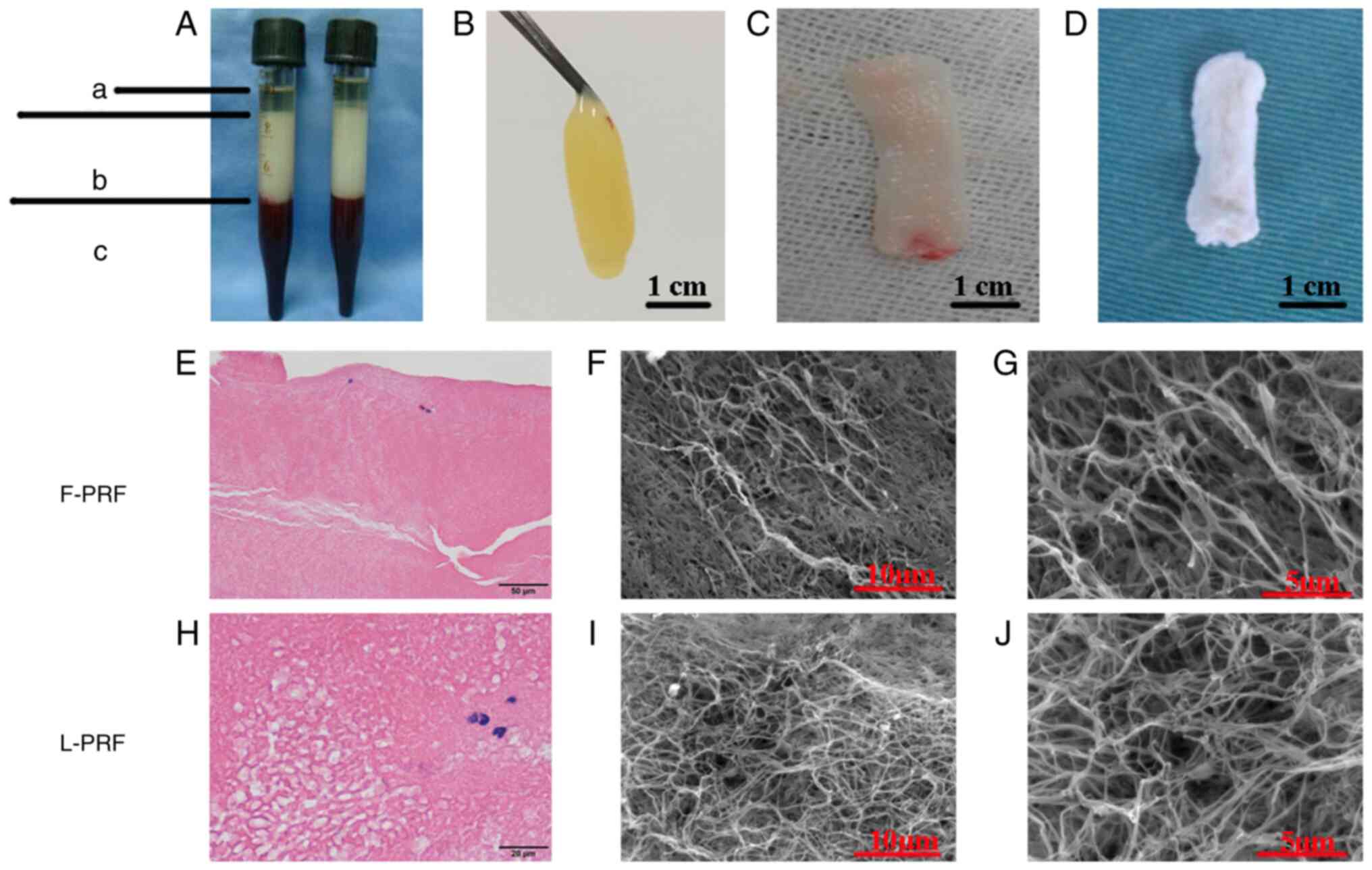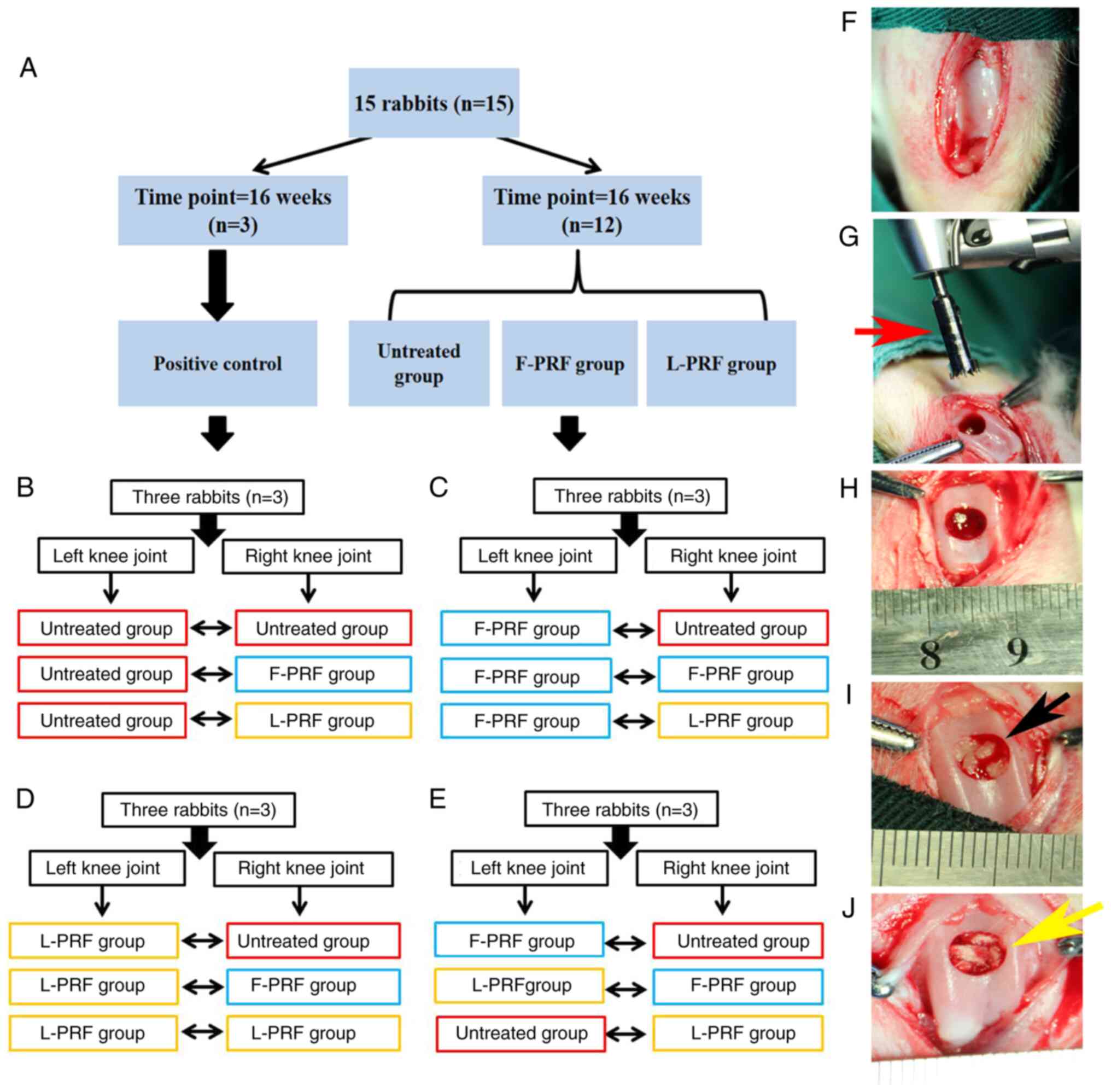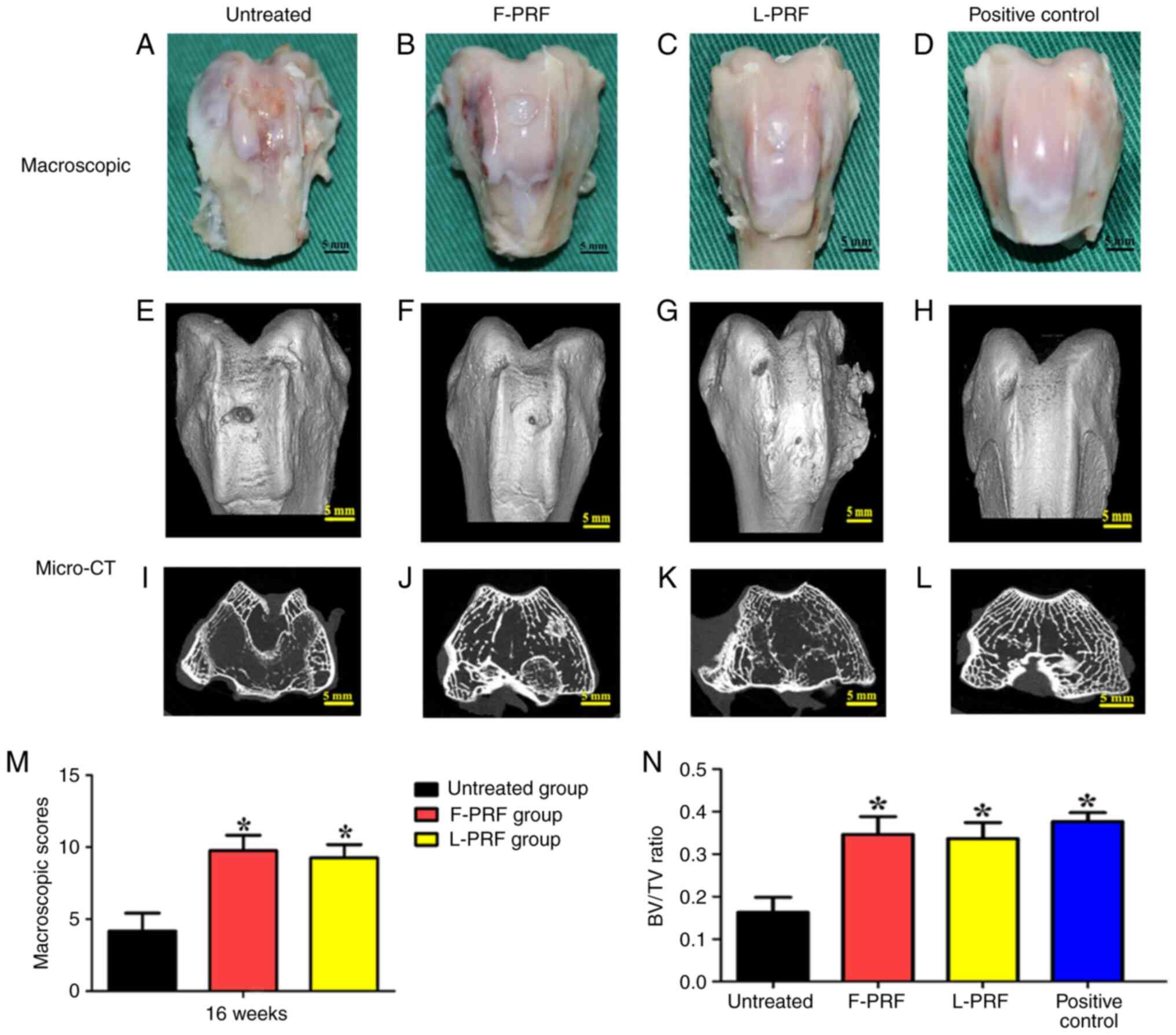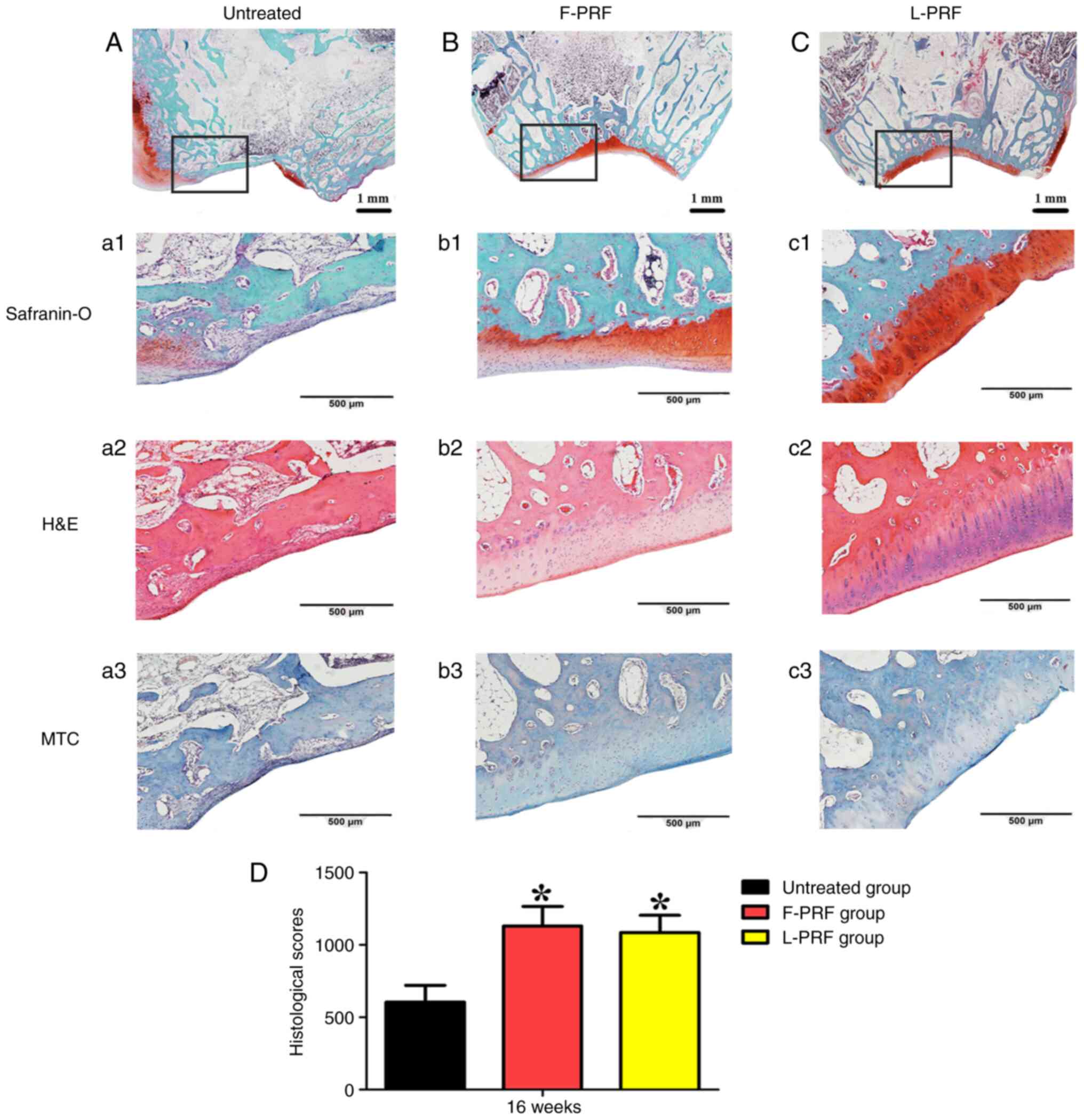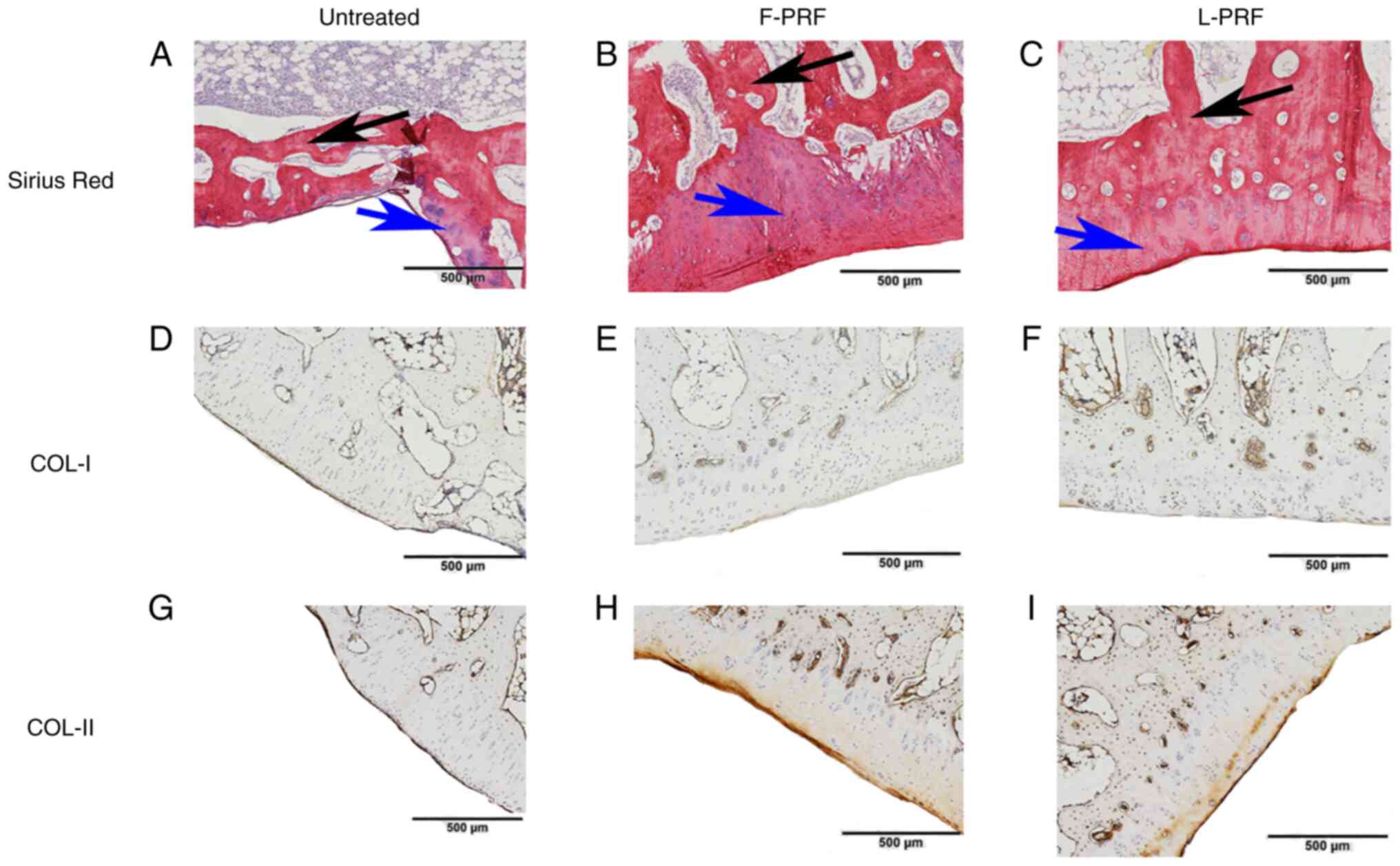|
1
|
Deng C, Chang J and Wu C: Bioactive
scaffolds for osteochondral regeneration. J Orthop Translat.
17:15–25. 2018.PubMed/NCBI View Article : Google Scholar
|
|
2
|
Xue J, Feng B, Zheng R, Lu Y, Zhou G, Liu
W, Cao Y, Zhang Y and Zhang WJ: Engineering ear-shaped cartilage
using electrospun fibrous membranes of gelatin/polycaprolactone.
Biomaterials. 34:2624–2631. 2013.PubMed/NCBI View Article : Google Scholar
|
|
3
|
Huey DJ, Hu JC and Athanasiou KA: Unlike
bone, cartilage regeneration remains elusive. Science. 338:917–921.
2012.PubMed/NCBI View Article : Google Scholar
|
|
4
|
Brittberg M, Lindahl A, Nilsson A, Ohlsson
C, Isaksson O and Peterson L: Treatment of deep cartilage defects
in the knee with autologous chondrocyte transplantation. N Engl J
Med. 331:889–895. 1994.PubMed/NCBI View Article : Google Scholar
|
|
5
|
Nooeaid P, Salih V, Beier JP and
Boccaccini AR: Osteochondral tissue engineering: Scaffolds, stem
cells and applications. J Cell Mol Med. 16:2247–2270.
2012.PubMed/NCBI View Article : Google Scholar
|
|
6
|
Mendelson A, Frank E, Allred C, Jones E,
Chen M, Zhao W and Mao JJ: Chondrogenesis by chemotactic homing of
synovium, bone marrow, and adipose stem cells in vitro. FASEB J.
25:3496–3504. 2011.PubMed/NCBI View Article : Google Scholar
|
|
7
|
Wang Z, Li Z, Li Z, Wu B, Liu Y and Wu W:
Cartilaginous extracellular matrix derived from decellularized
chondrocyte sheets for the reconstruction of osteochondral defects
in rabbits. Acta Biomater. 81:129–145. 2018.PubMed/NCBI View Article : Google Scholar
|
|
8
|
Lee CH, Cook JL, Mendelson A, Moioli EK,
Yao H and Mao JJ: Regeneration of the articular surface of the
rabbit synovial joint by cell homing: A proof of concept study.
Lancet. 376:440–448. 2010.PubMed/NCBI View Article : Google Scholar
|
|
9
|
Zlotnick HM, Locke RC, Stoeckl BD, Patel
JM, Gupta S, Browne KD, Koh J, Carey JL and Mauck RL: Marked
differences in local bone remodelling in response to different
marrow stimulation techniques in a large animal. Eur Cell Mater.
41:546–557. 2021.PubMed/NCBI View Article : Google Scholar
|
|
10
|
Park MS, Kim YH, Jung Y, Kim SH, Park JC,
Yoon DS, Kim SH and Lee JW: In situ recruitment of human bone
marrow-derived mesenchymal stem cells using chemokines for
articular cartilage regeneration. Cell Transplant. 24:1067–1083.
2015.PubMed/NCBI View Article : Google Scholar
|
|
11
|
Kazemi D, Fakhrjou A, Dizaji VM and
Alishahi MK: Effect of autologous platelet rich fibrin on the
healing of experimental articular cartilage defects of the knee in
an animal model. Biomed Res Int. 2014(486436)2014.PubMed/NCBI View Article : Google Scholar
|
|
12
|
Dohan DM, Choukroun J, Diss A, Dohan SL,
Dohan AJ, Mouhyi J and Gogly B: Platelet-rich fibrin (PRF): A
second-generation platelet concentrate. Part I: Technological
concepts and evolution. Oral Surg Oral Med Oral Pathol Oral Radiol
Endod. 101:e37–e44. 2006.PubMed/NCBI View Article : Google Scholar
|
|
13
|
Serra CI, Soler C, Carrillo JM, Sopena JJ,
Redondo JI and Cugat R: Effect of autologous platelet-rich plasma
on the repair of full-thickness articular defects in rabbits. Knee
Surg Sports Traumatol Arthrosc. 21:1730–1736. 2013.PubMed/NCBI View Article : Google Scholar
|
|
14
|
Wang Z, Weng Y, Lu S, Zong C, Qiu J, Liu Y
and Liu B: Osteoblastic mesenchymal stem cell sheet combined with
Choukroun platelet-rich fibrin induces bone formation at an ectopic
site. J Biomed Mater Res B Appl Biomater. 103:1204–1216.
2015.PubMed/NCBI View Article : Google Scholar
|
|
15
|
Wang Z, Hu H, Li Z, Weng Y, Dai T, Zong C,
Liu Y and Liu B: Sheet of osteoblastic cells combined with
platelet-rich fibrin improves the formation of bone in
critical-size calvarial defects in rabbits. Br J Oral Maxillofac
Surg. 54:316–321. 2016.PubMed/NCBI View Article : Google Scholar
|
|
16
|
Wang Z, Han L, Sun T, Wang W, Li X and Wu
B: Preparation and effect of lyophilized platelet-rich fibrin on
the osteogenic potential of bone marrow mesenchymal stem cells in
vitro and in vivo. Heliyon. 5(e02739)2019.PubMed/NCBI View Article : Google Scholar
|
|
17
|
Lei X, Yang Y, Shan G, Pan Y and Cheng B:
Preparation of ADM/PRP freeze-dried dressing and effect of mice
full-thickness skin defect model. Biomed Mater.
14(035004)2019.PubMed/NCBI View Article : Google Scholar
|
|
18
|
Chumroenphat T, Somboonwatthanakul I,
Saensouk S and Siriamornpun S: Changes in curcuminoids and chemical
components of turmeric (Curcuma longa L.) under freeze-drying and
low-temperature drying methods. Food Chem.
339(128121)2021.PubMed/NCBI View Article : Google Scholar : Haugh MG, Murphy
CM and O'Brien FJ: Novel freeze-drying methods to produce a range
of collagen-glycosaminoglycan scaffolds with tailored mean pore
sizes. Tissue Eng Part C Methods 16: 887-894, 2010.
|
|
19
|
Shi L, Li R, Wei S, Zhou M, Li L, Lin F,
Li Y, Guo Z, Zhang W, Chen M and Shan G: Effects of a protective
agent on freeze-dried platelet-rich plasma. Blood Coagul
Fibrinolysis. 30:58–65. 2019.PubMed/NCBI View Article : Google Scholar
|
|
20
|
Ba R, Wei J, Li M, Cheng X, Zhao Y and Wu
W: Cell-bricks based injectable niche guided persistent ectopic
chondrogenesis of bone marrow-derived mesenchymal stem cells and
enabled nasal augmentation. Stem Cell Res Ther.
6(16)2015.PubMed/NCBI View Article : Google Scholar
|
|
21
|
van den Borne MP, Raijmakers NJ, Vanlauwe
J, Victor J, de Jong SN, Bellemans J and Saris DB: International
Cartilage Repair Society. International cartilage repair society
(ICRS) and oswestry macroscopic cartilage evaluation scores
validated for use in autologous chondrocyte implantation (ACI) and
microfracture. Osteoarthritis Cartilage. 15:1397–1402.
2007.PubMed/NCBI View Article : Google Scholar
|
|
22
|
Mainil-Varlet P, Van Damme B, Nesic D,
Knutsen G, Kandel R and Roberts S: A new histology scoring system
for the assessment of the quality of human cartilage repair: ICRS
II. Am J Sports Med. 38:880–890. 2010.PubMed/NCBI View Article : Google Scholar
|
|
23
|
Wang Z, Han L, Sun T, Ma J, Sun S, Ma L
and Wu B: Extracellular matrix derived from allogenic
decellularized bone marrow mesenchymal stem cell sheets for the
reconstruction of osteochondral defects in rabbits. Acta Biomater.
118:54–68. 2020.PubMed/NCBI View Article : Google Scholar
|
|
24
|
Temmerman A, Cleeren GJ, Castro AB,
Teughels W and Quirynen M: L-PRF for increasing the width of
keratinized mucosa around implants: A split-mouth, randomized,
controlled pilot clinical trial. J Periodontal Res. 53:793–800.
2018.PubMed/NCBI View Article : Google Scholar
|
|
25
|
Sameera S, Nagasri M, Aravind Kumar P,
Indeevar P, Raviraj K and Musalaiah SVVS: Comparison of two
surgical techniques in the treatment of multiple gingival
recessions sandwiched with a combination of A-PRF and L-PRF. Saudi
Dent J. 30:183–189. 2018.PubMed/NCBI View Article : Google Scholar
|
|
26
|
Beitzel K, McCarthy MB, Cote MP, Russell
RP, Apostolakos J, Ramos DM, Kumbar SG, Imhoff AB, Arciero RA and
Mazzocca AD: Properties of biologic scaffolds and their response to
mesenchymal stem cells. Arthroscopy. 30:289–298. 2014.PubMed/NCBI View Article : Google Scholar
|
|
27
|
Dohan DM, Choukroun J, Diss A, Dohan SL,
Dohan AJ, Mouhyi J and Gogly B: Platelet-rich fibrin (PRF): A
second-generation platelet concentrate. Part III: Leucocyte
activation: a new feature for platelet concentrates? Oral Surg Oral
Med Oral Pathol Oral Radiol Endod. 101:e51–e55. 2006.PubMed/NCBI View Article : Google Scholar
|
|
28
|
Ma L, Wang X, Zhao N, Zhu Y, Qiu Z, Li Q,
Zhou Y, Lin Z, Li X, Zeng X, et al: Integrating 3D printing and
biomimetic mineralization for personalized enhanced osteogenesis,
angiogenesis, and osteointegration. ACS Appl Mater Interfaces.
10:42146–42154. 2018.PubMed/NCBI View Article : Google Scholar
|
|
29
|
Isobe K, Watanebe T, Kawabata H, Kitamura
Y, Okudera T, Okudera H, Uematsu K, Okuda K, Nakata K, Tanaka T and
Kawase T: Mechanical and degradation properties of advanced
platelet-rich fibrin (A-PRF), concentrated growth factors (CGF),
and platelet-poor plasma-derived fibrin (PPTF). Int J Implant Dent.
3(17)2017.PubMed/NCBI View Article : Google Scholar
|
|
30
|
Pichotano EC, de Molon RS, de Souza RV,
Austin RS, Marcantonio E and Zandim-Barcelos DL: Evaluation of
L-PRF combined with deproteinized bovine bone mineral for early
implant placement after maxillary sinus augmentation: A randomized
clinical trial. Clin Implant Dent Relat Res. 21:253–262.
2019.PubMed/NCBI View Article : Google Scholar
|
|
31
|
Lundquist R, Dziegiel MH and Agren MS:
Bioactivity and stability of endogenous fibrogenic factors in
platelet-rich fibrin. Wound Repair Regen. 16:356–363.
2008.PubMed/NCBI View Article : Google Scholar
|
|
32
|
Dohan Ehrenfest DM, Del Corso M, Diss A,
Mouhyi J and Charrier JB: Three-dimensional architecture and cell
composition of a Choukroun's platelet-rich fibrin clot and
membrane. J Periodontol. 81:546–555. 2010.PubMed/NCBI View Article : Google Scholar
|
|
33
|
White JG: Platelet secretion during clot
retraction. Platelets. 11:331–343. 2000.PubMed/NCBI View Article : Google Scholar
|
|
34
|
Mao Z, Bi X, Wu C, Zheng Y, Shu X, Wu S,
Guan J and Ritchie RO: A cell-free silk fibroin biomaterial
strategy promotes in situ cartilage regeneration via programmed
releases of bioactive molecules. Adv Healthc Mater.
12(e2201588)2023.PubMed/NCBI View Article : Google Scholar
|
|
35
|
Ravindran S, Kotecha M, Huang CC, Ye A,
Pothirajan P, Yin Z, Magin R and George A: Biological and MRI
characterization of biomimetic ECM scaffolds for cartilage tissue
regeneration. Biomaterials. 71:58–70. 2015.PubMed/NCBI View Article : Google Scholar
|
|
36
|
Crapo PM, Gilbert TW and Badylak SF: An
overview of tissue and whole organ decellularization processes.
Biomaterials. 32:3233–3243. 2011.PubMed/NCBI View Article : Google Scholar
|
|
37
|
Cortiella J, Niles J, Cantu A, Brettler A,
Pham A, Vargas G, Winston S, Wang J, Walls S and Nichols JE:
Influence of acellular natural lung matrix on murine embryonic stem
cell differentiation and tissue formation. Tissue Eng Part A.
16:2565–2580. 2010.PubMed/NCBI View Article : Google Scholar
|
|
38
|
Li Z, Ba R, Wang Z, Wei J, Zhao Y and Wu
W: Angiogenic potential of human bone marrow-derived mesenchymal
stem cells in chondrocyte brick-enriched constructs promoted stable
regeneration of craniofacial cartilage. Stem Cells Transl Med.
6:601–612. 2017.PubMed/NCBI View Article : Google Scholar
|
|
39
|
Li J, Kang F, Gong X, Bai Y, Dai J, Zhao
C, Dou C, Cao Z, Liang M, Dong R, et al: Ceria nanoparticles
enhance endochondral ossification-based critical-sized bone defect
regeneration by promoting the hypertrophic differentiation of BMSCs
via DHX15 activation. FASEB J. 33:6378–6389. 2019.PubMed/NCBI View Article : Google Scholar
|
|
40
|
Gaut C and Sugaya K: Critical review on
the physical and mechanical factors involved in tissue engineering
of cartilage. Regen Med. 10:665–679. 2015.PubMed/NCBI View Article : Google Scholar
|
|
41
|
Nukavarapu SP and Dorcemus DL:
Osteochondral tissue engineering: current strategies and
challenges. Biotechnol Adv. 31:706–721. 2013.PubMed/NCBI View Article : Google Scholar
|
|
42
|
Brown BN and Badylak SF: Extracellular
matrix as an inductive scaffold for functional tissue
reconstruction. Transl Res. 163:268–285. 2014.PubMed/NCBI View Article : Google Scholar
|















